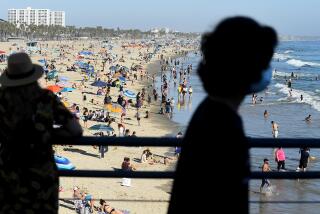Cancer Deaths to Decline, Study Says
- Share via
Cancer rates and deaths will continue declining in Orange County and throughout the state next year, according to a survey released last week by the American Cancer Society.
A predicted drop in deaths in Orange County mimics similar declines statewide across a broad range of cancers, according to the annual report released by the California Cancer Registry, which records and predicts cancer data for the state.
Experts attributed the predicted decrease--which follows a national trend that began in 1992--to improved treatment and increased screening.
More cancers are being diagnosed in their early stages, when “they are easier to cure or it is easier to postpone death from those cancers,” said Robert Schlag, chief of the research and surveillance program for the cancer registry, which is part of the state Department of Health Services.
Orange County deaths from all types of cancer are predicted to drop 10% to 3,990 in 2000. Deaths from breast cancer are predicted to fall 17% to 340, the largest such decline for any California county, officials said.
Dr. Glen R. Justice, president of the American Cancer Society in Orange County, attributed the projected decline in breast cancer deaths to better treatment with chemotherapy, the drug tamoxifen and massive screening programs.
“There is no question that with annual mammograms you pick up the disease earlier. . . . When you diagnose later, the mortality rate is higher.”
Experts said early detection was also paying off in declines statewide in deaths from cervical cancer and colo-rectal cancer. From 1988 to 1996, actual reported deaths due to cancer declined 13%, while the incidence of cancer fell 7%, the report said.
The data, released Friday, use the actual numbers of cancer cases and deaths as reported through 1996 to predict outcomes for 2000. The statistical analysis combines those numbers with changes in demographics and total population in each county to make predictions for the coming year, said Schlag.
Tobacco-related cancer--including lung, oral, stomach, pancreas and bladder--will decline sharply but remain among the most difficult to treat, the report said. Lung cancer alone will cause nearly 18,000 deaths statewide, more than prostate, breast, colon and rectum cancers combined.
The California Cancer Registry predicts that 53,565 people will die of cancer next year, 51% of them men. That’s down 2.5% from the 54,945 predicted deaths in 1999.
These numbers are even more impressive, said experts, because the population has grown and is aging. Older people get cancer at an increased rate.
In fact, the number of cancers diagnosed will be up slightly in real terms, but the rate per 100,000 is expected to decline. The predicted cancer cases of all types for 1999 in the state is 132,510, while for 2000 it is 133,060.
Statewide, the five most common causes of predicted cancer deaths for women in 2000 are: lung cancer (29% of all cancers for women), breast (17%), colon and rectum (10%), leukemia and lymphoma (8%), and pancreas (6%).
For men, the most common causes of cancer deaths are: lung (29%), prostate (12%), colon and rectum (10%), leukemia and lymphoma (9%), and pancreas (5%).
Only two of the top 10 cancers are predicted to increase in sheer numbers in California. They are breast and prostate cancer, though the rate per 100,000 for breast cancer will decline.
The survival rate for both is quite high, according to the report--about 90%.
Prostate cancer cases are predicted to rise from 18,860 diagnosed cases in 1999 to 21,180 in 2000, according to the report. Prostate cancer is the most common cause of cancer in men, though it does not lead in mortality.
The rise in diagnoses has been dramatic throughout the 1990s because of the introduction of the prostate-specific antigen test for early detection, said experts.
(BEGIN TEXT OF INFOBOX / INFOGRAPHIC)
Fewer Deaths
Orange County cancer deaths are projected to decline 10% in 2000, following a national trend. The largest drops are expected for breast and stomach cancer. Numbers for both years are estimated.
*--*
1999 2000 change Lung 1,170 1,065 -9.0% Colon/rectum 435 395 -9.2 Breast 410 340 -17.1 Prostate 240 210 -12.5 Pancreas 245 235 -4.1 Non-Hodgkins lymphoma 190 175 -7.9 Leukemia 190 160 -15.8 Stomach 145 120 -17.2 Ovary 130 120 -7.7 Bladder 90 85 -5.6 Uterus/cervix 90 80 -11.1 All 4,435 3,990 -10.0
*--*
Source: California Cancer Registry
More to Read
Sign up for Essential California
The most important California stories and recommendations in your inbox every morning.
You may occasionally receive promotional content from the Los Angeles Times.













